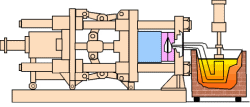Zinc Die Casting Machine and How They Work. Die casting machines are of two basic types. One is the zinc hot chamber machines. This is also called the “gooseneck machines.” The other type is the cold chamber machines.
To feed the die, the zinc hot chamber die casting machines depend upon a pool of molten metal. At the start of cycle, the machine’s piston is drawn back and this gives way for the molten metal to fill the “goose neck.” Piston then forces zinc metal out of the gooseneck and sent to the die. This system has a fast cycling time and melting the metal in the casting machine is convenient. However, in this system, high-melting point metals cannot be utilized. Also aluminum cannot be used. Aluminum picks up iron. For this reason, hot chamber machines utilize zinc, tin and lead based alloys.
When the die casting alloy cannot be used in zinc hot chamber die casting machines, then the cold chamber machines are used instead. Among these alloys are magnesium, aluminum, copper and zinc alloys with a big composition of aluminum. The cold chamber system has a shower cycle time. This is due to the need to transfer molten metal from the furnace to the cold chamber machine.
Since cast irons cannot withstand high pressures, the dies and zinc die casting tools used in die casting are often made out of hardened tool steels. This makes dies very costly, and consequently high start up costs. There are also cores involved to cast features such as undercuts. Since they disintegrate due to high pressures, sand cores cannot be used in zinc die casting and die casting tooling. Metal cores are used instead. Wear and erosion limit a die’s life. This is strongly dependent on the molten zinc metal’s temperature.


